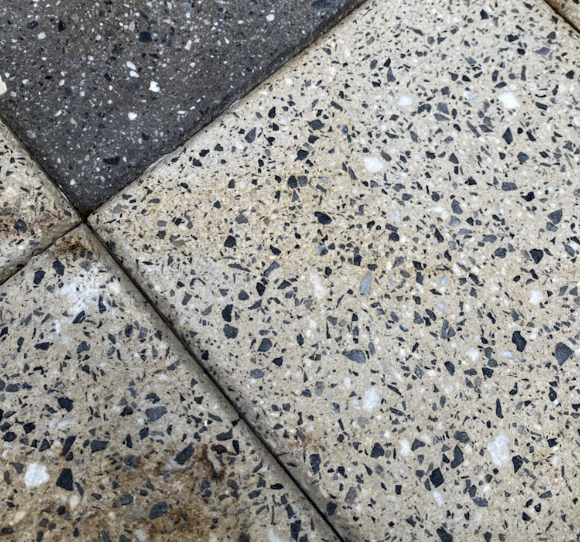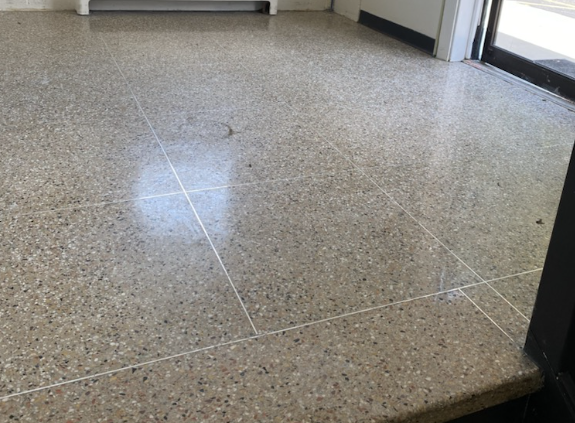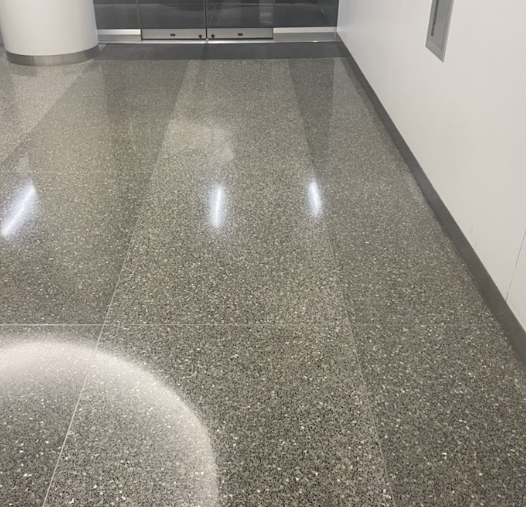Terrazzo
Restoring terrazzo involves several key steps to repair and rejuvenate the surface, ensuring it maintains its original beauty and functionality. Here’s an overview of the typical restoration process:
Assessment and Inspection:
- Evaluation: A thorough inspection of the terrazzo surface is conducted to identify issues such as stains, scratches, cracks, and general wear. This helps determine the appropriate restoration techniques.
- Testing: Testing may be performed to assess the type of terrazzo and the extent of damage to guide the restoration approach.
Cleaning:
- Surface Cleaning: The terrazzo is cleaned with a pH-balanced cleaner to remove dirt, grime, and surface stains. This step helps prepare the surface for further restoration work.
- Deep Cleaning: For tougher stains or accumulated grime, more intensive cleaning methods, including poultice applications, may be used to lift stains from the surface.
Repair:
- Crack and Chip Repair: Any cracks or chips in the terrazzo are filled with a matching epoxy or cement-based compound. The repaired areas are then leveled and blended with the surrounding surface.
- Resurfacing: If the terrazzo surface is extensively worn or damaged, resurfacing with a new layer of terrazzo may be necessary. This involves applying a new layer of terrazzo mixture over the existing surface.
Grinding and Honing:
- Grinding: To address unevenness and remove surface imperfections, the terrazzo is ground using diamond abrasive tools. This step is crucial for smoothing the surface and preparing it for polishing.
- Honing: The surface is honed with progressively finer abrasives to achieve a smooth and uniform finish. Honing removes scratches and helps refine the surface before polishing.
Polishing:
- Initial Polishing: Polishing compounds are applied to bring out the natural luster of the terrazzo. This step involves buffing the surface with fine abrasives to enhance its shine.
- Final Polishing: A final polishing step may be performed to achieve the desired level of sheen and enhance the terrazzo’s appearance.
Sealing:
- Application: A high-quality sealer is applied to protect the terrazzo from staining and moisture. Sealing helps to maintain the surface’s appearance and make it easier to clean.
- Maintenance: Regular resealing may be required to ensure ongoing protection and preserve the terrazzo’s beauty.
Final Inspection and Touch-ups:
- Review: A final inspection ensures that all restoration work meets high standards and that the terrazzo looks as intended.
- Touch-ups: Any minor touch-ups or adjustments are made to perfect the finish and address any remaining issues.
Why Restore Terrazzo?
- Aesthetic Appeal: Restoration revitalizes the terrazzo, bringing back its original shine and enhancing its colorful and unique appearance.
- Durability: Proper restoration maintains the terrazzo’s durability and extends its lifespan.
- Value: Well-maintained terrazzo can enhance the value and appeal of a property, offering a sophisticated and long-lasting flooring option.
Restoring terrazzo requires specialized skills and equipment to achieve the best results. By following these steps, professionals can effectively rejuvenate terrazzo surfaces, ensuring they continue to look stunning and perform well for many years.


